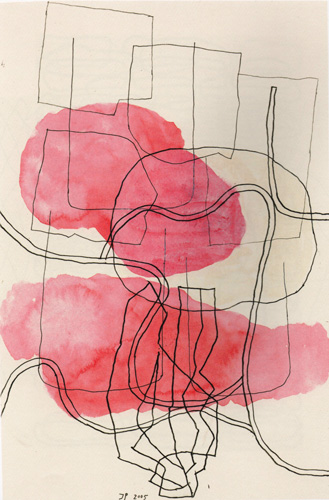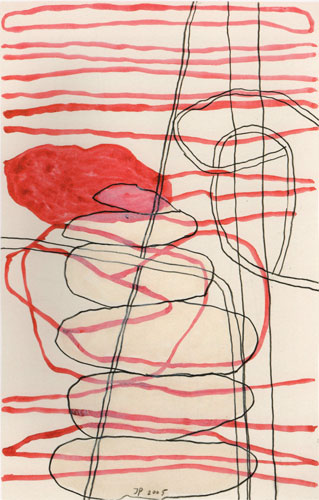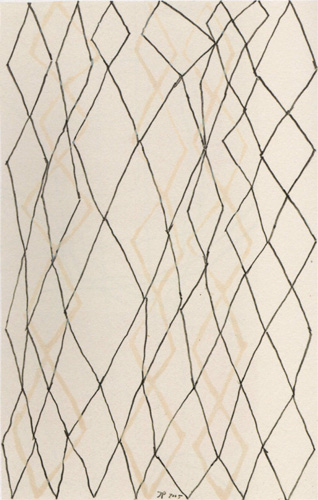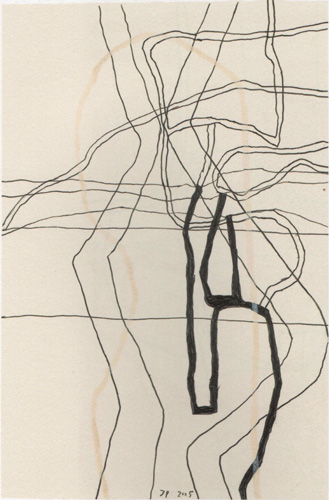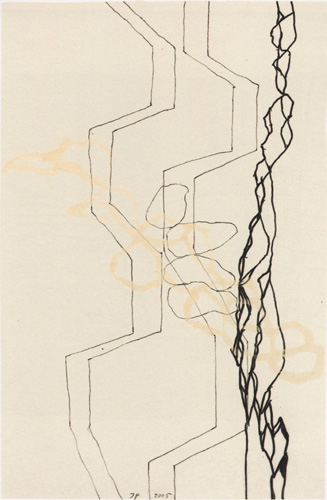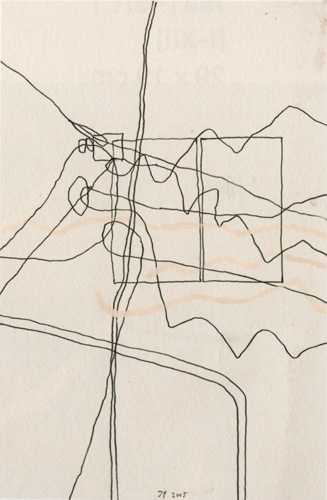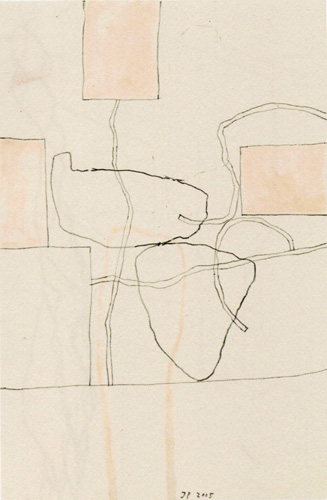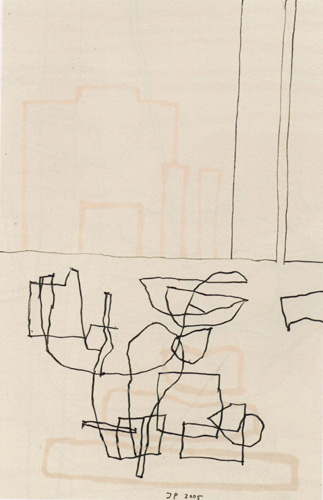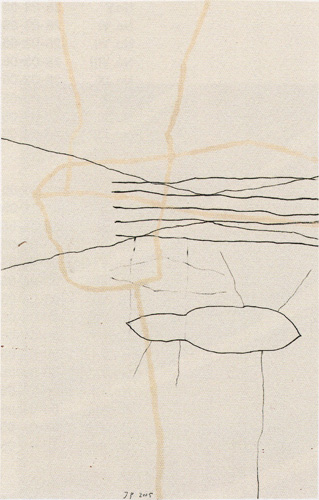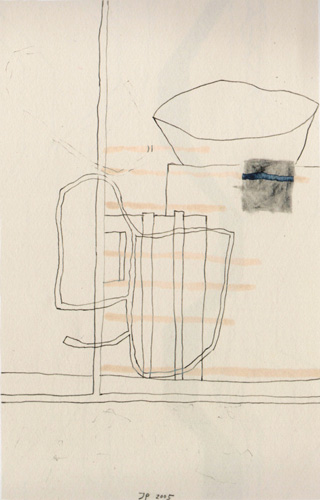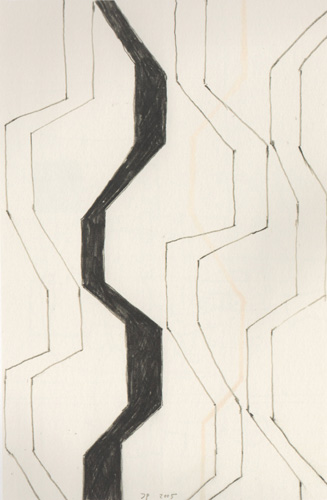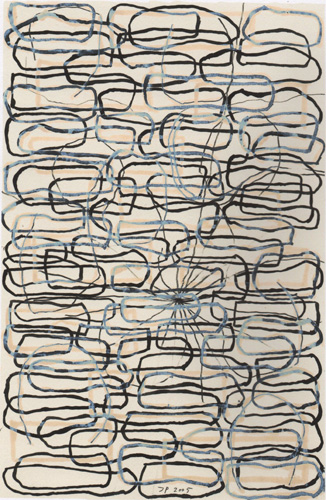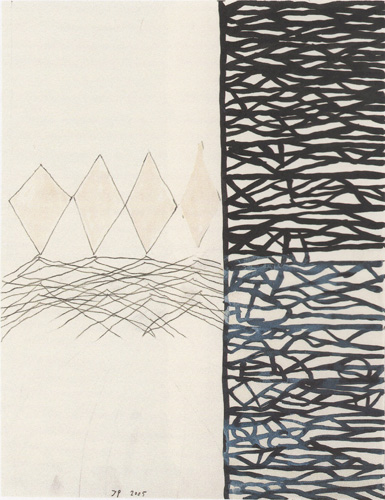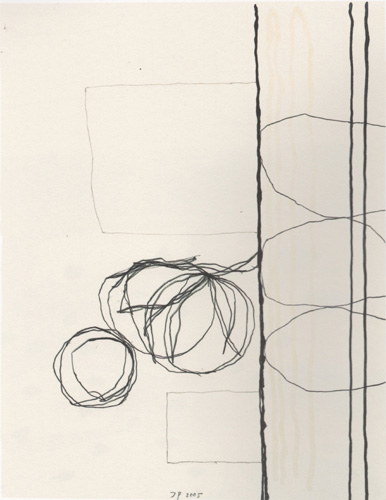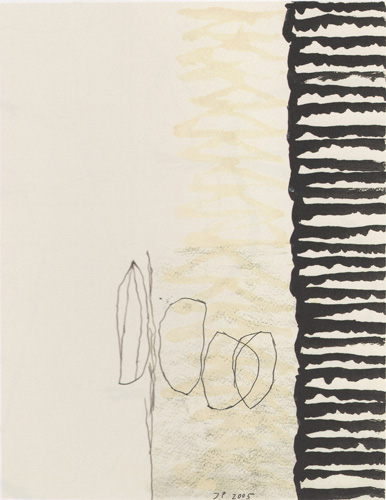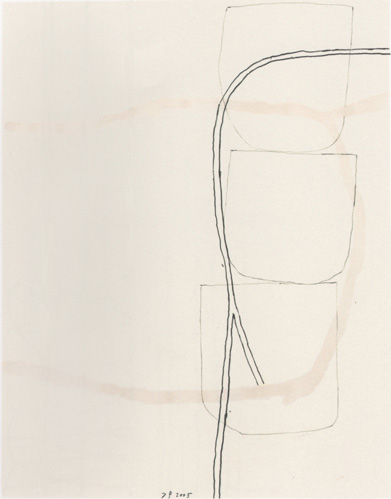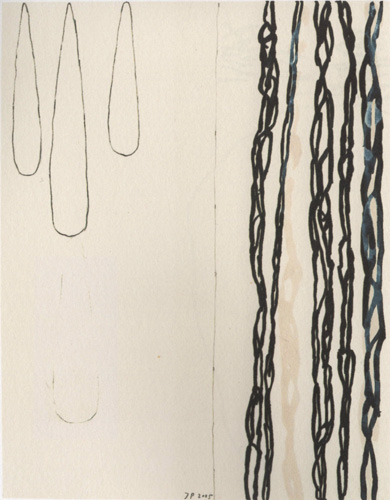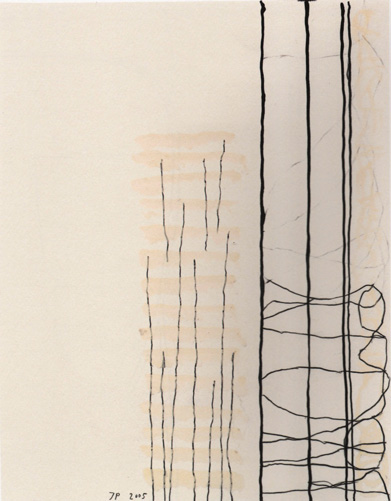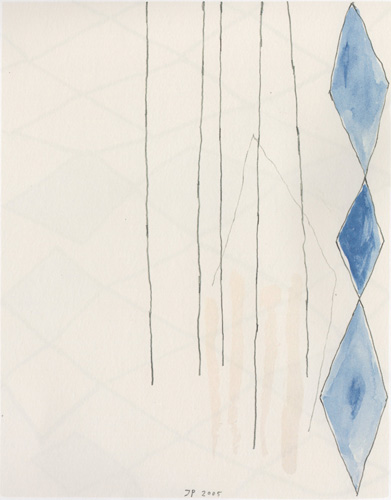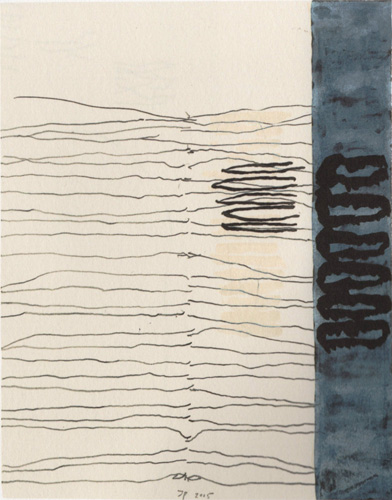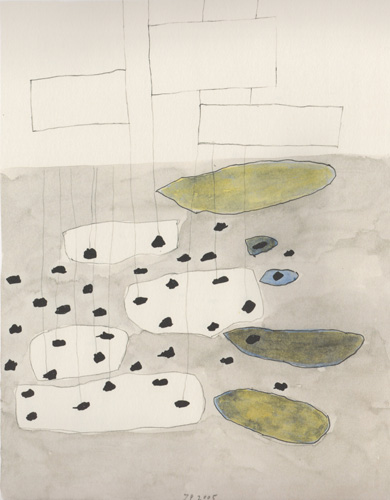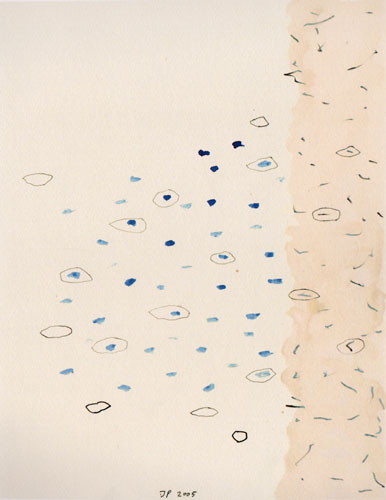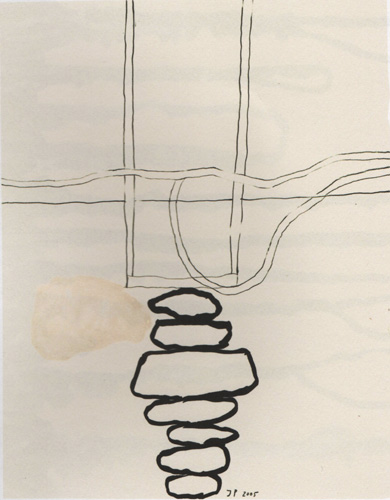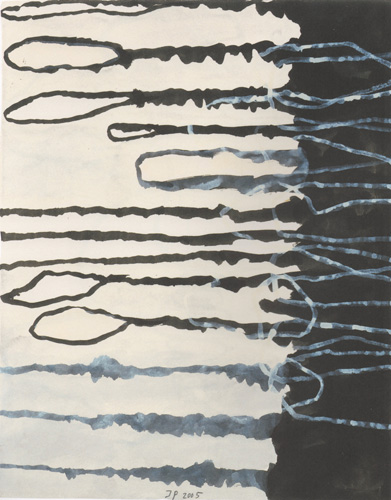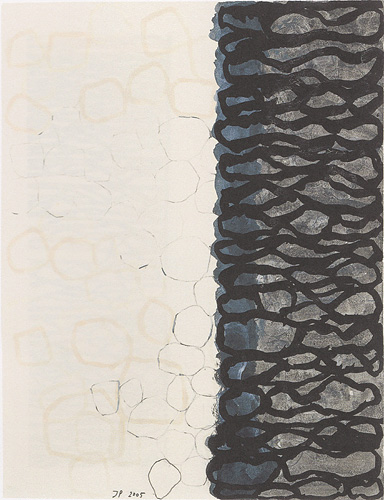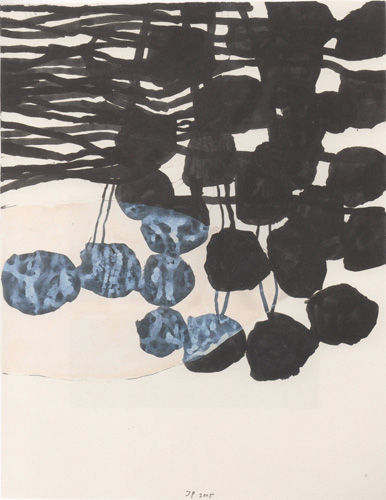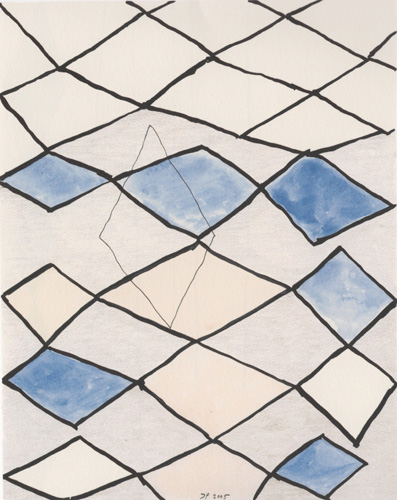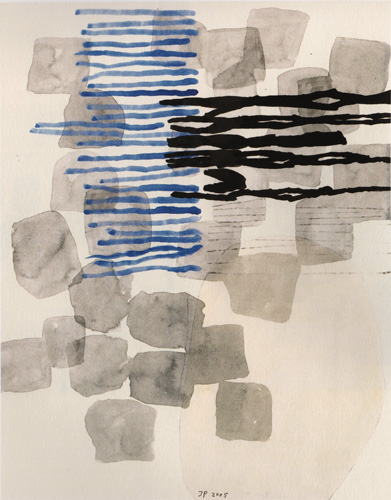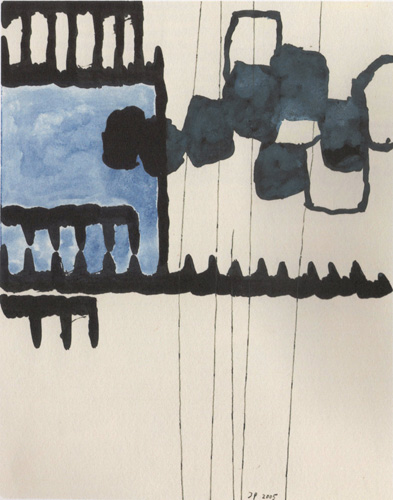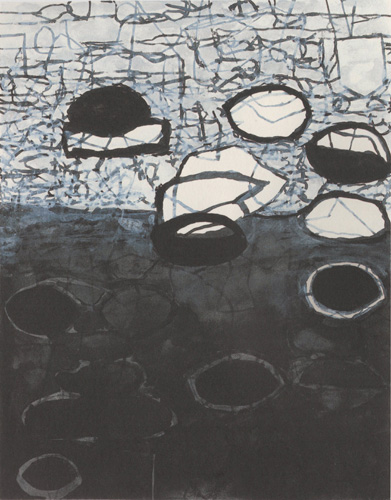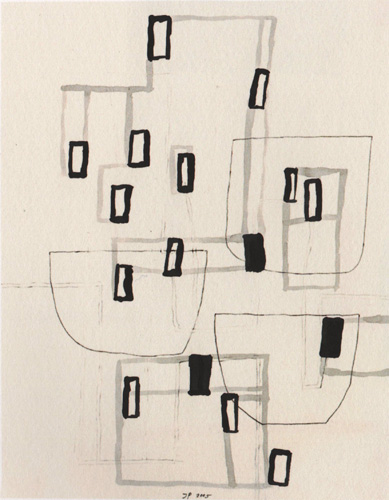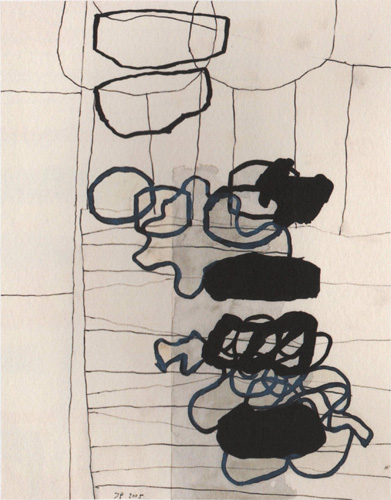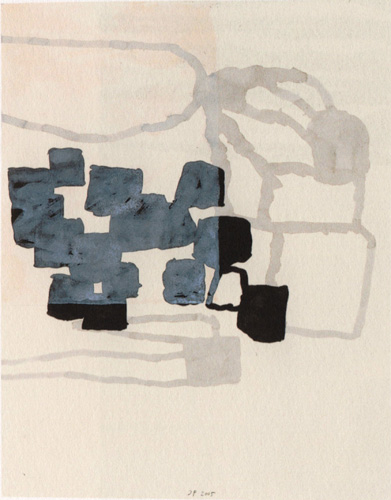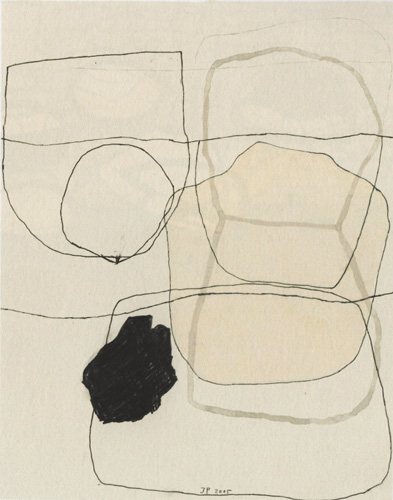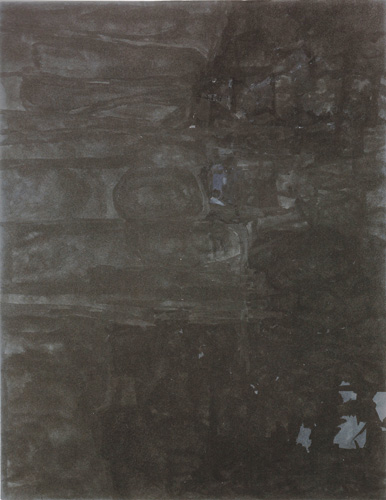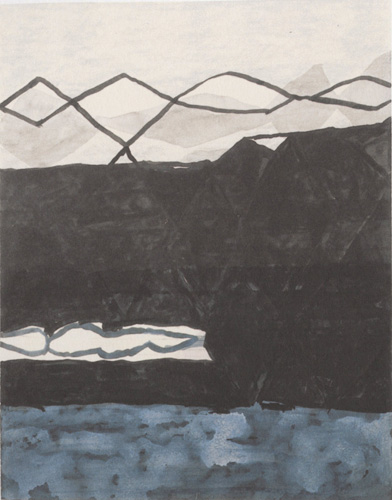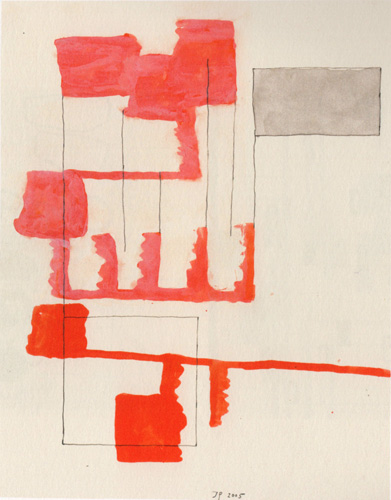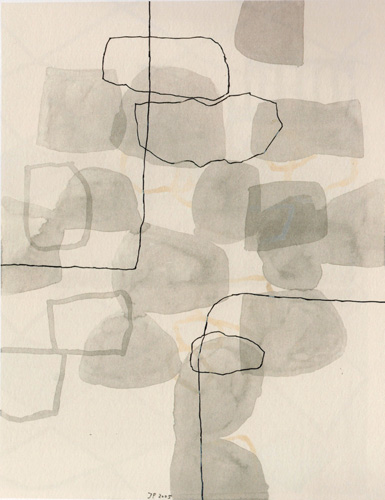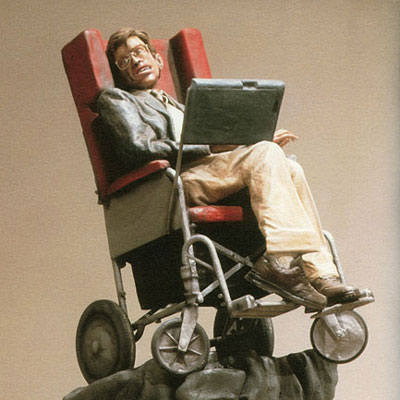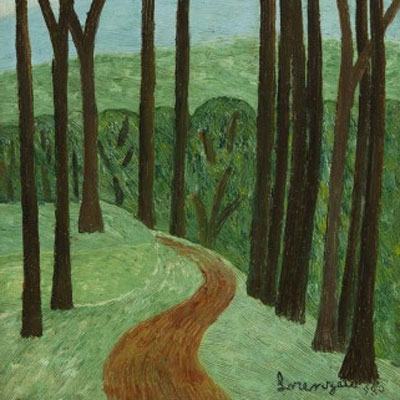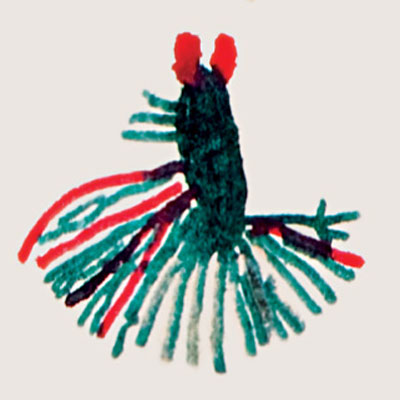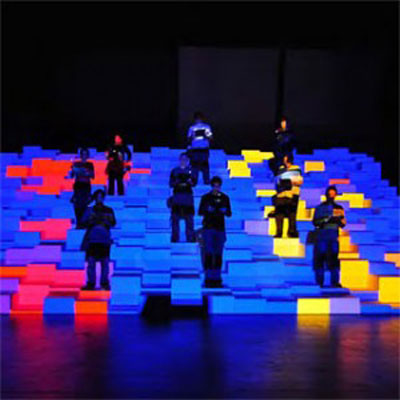The “cybernetic shift” that has been giving growing relevance since the 1960s to information (digital and/or genetic) in all spheres of human activity in order to reconfigure our understanding of life, work and knowledge, does not yet seem to have managed to trigger off in artists an awareness of the radical change of perspective it requires. Indeed, anyone frequenting contemporary art exhibitions and wishing to compare…
[I]
Whether European, Chinese or Brazilian, art critics and commentators of Partenheimer’s work often point to the meditative, aerial, carefree, imaginative and even lyrical nature of his drawings and paintings, never failing to mention the enigmatic balance which makes his work and the silence that appears to inhabit it so highly recognizable (consider the Roman Diary, Carmen, De Coloribus, and Zur Grammatik series or Die fragilen Apparate des Geometers, to name but a few [1]). These features are also present in a series of drawings produced in 2004, titled Suave loucura [Gentle Madness] after a book about the artist published in São Paulo following a show of his work in that city’s Pinacoteca. But, as spectators of the São Paulo Diary will readily perceive, something akin to a disturbance has taken place in this series of drawings which deeply affected the artist’s work; for one’s initial reaction to them is one of wonder at what might have happened to sweep away that “gentle madness” and bring about a new, hitherto unknown situation of turbulence. Whence comes this commotion that rocks Partenheimer’s metaphysical realism and leads him to experience the act of creation as a different, altogether new register? To see or to revisit the works of the São Paulo Diary is to be part of an adventure that allows us to glimpse in its drawings the ways by which Partenheimer converges and diverges with a metropolis in which urbanism and architecture intrude as drawings in the drawing itself! An operation requiring a purification of the gaze as radical as that to which the artist submitted himself in order to be transformed into a sort of agent of this contact of which the Diary is at once “scene” and “effect”.
[1] See Jürgen Partenheimer. Die Verschickung der Oste, Kunstverein, Göttingen; Kunstverein, Dortmund, 1997; Häusler, Christa [ed.] Jürgen Partenheimer. Follow the Rabbit. Heike Kurtze, Wien, 1990; CrossMapping. Partenheimer in China. Richter Verlag. Beijing-Nanjing, Düsseldorf, 2001; Jürgen Partenheimer. Suave loucura. Pinacoteca do Estado-Estação Liberdade, São Paulo, 2005.
On the occasion of his exhibition at the Pinacoteca, Partenheimer mounted and subsequently photographed several oils from his Carmen series within the urban landscape of São Paulo. As Jan Thorn-Prikker astutely observed, “Used as an exhibition venue with such directness and immediacy, the city passed its comments on the exhibits likewise, and simply swallowed them up. (…) The abstractions suddenly reveal what they are abstractions from. The world that makes the works disappear is the very same world that disappears in the works. The city swallows the pictures because it is the biggest picture itself. (…) Partenheimer’s works may be seen as attempts at translation, as transformations, as answers to questions posed by the artist and no one else. They respond to the strangeness of the world with their own strangeness. The most important contribution made by Partenheimer’s drawings is their patient, clear-sighted insistence on their own characteristic language. As attempted translations of the world, they overcome their subject matter in the very act of translation.” [2]
[2] Thorn-Prikker, Jan. “Perdidos na Tradução/Lost in Translation”, in Suave loucura, op. cit. pp.72, 74 and 75.
This “exhibition” preceded the São Paulo Diary, which must therefore be seen as the production of a series of drawings following the movement of Partenheimer’s approximation to the metropolis. Thus, the artist initially goes to the city and inscribes his works within its fluxes, accepting that they will be “swallowed up” by it; said movement to be later inverted as follows – São Paulo comes to the artist, cloistered in his workplace yet willing to welcome and, perhaps, to swallow it.
However, in order for the encounters to take place (or not), Partenheimer must lay himself bare as artist and individual and submit himself to a sort of borderline situation that will provide him with access to a level in which what matters is neither the subjectivity of one who draws nor the alleged objectivity of the world but, rather, a relationship in which what is drawn is the reception or “resolution” of constitutive forces of both the environment and the subject, which can only exist in the contact between both and can only manifest themselves as an expression of this contact. In a sense, Partenheimer needed to prepare for this contact, to de-program himself and retreat to a sort of borderline reality in order to gain access to an instinctive perception, the only one that might reveal what Beckett calls, in Proust, “the radiological quality of his observation” (that is to say, the ability to capture what is seen and not what one knows one ought to see, of capturing impressions according to “his non-logical statement of phenomena in the order and exactitude of their perception, before they have been distorted into intelligibility to be forced into a chain of cause and effect”.[3] Only under these conditions can drawing be worthwhile, the act of drawing being understood not as a representation of what is being x-rayed both on the subject’s side and on the object’s side, but as the fulfillment of the exercise of vision itself.
[3] Beckett, Samuel. Proust. Grove Press, New York, 1931, pp. 67 and ff.
In order to assume this condition of seeing with the drawings and through them, Partenheimer submits himself to a sort of “training camp”, cloistering himself in an apartment on the 28th floor of the Copan building in downtown São Paulo and dedicating himself to the writing of a journal. Such a procedure (such discipline, in fact) is part of a method designed to set himself “in the situation” and to set a process in motion. But there is no need to read that other diary in order to see the compositions of the São Paulo Diary – the drawings stand wonderfully on their own (although it must be admitted that the crossbreeding of viewing and reading can sharpen aesthetic experience). The issue might be best served by an example. Even before having access to Partenheimer’s writings and reading (in fragment 3) a reference to Henri Michaux’s La vie dans le plis, one could perceive, in the third drawing of the series 1.[VI], a resonance between the work of the two artists, namely that the space is interrupted by broken lines, tremors, breaks, disordered movements which make it impossible not to recall the fêlures seismographed by Michaux under the effect of mescaline in Misérable miracle.[4] According to the French artist/poet’s gaze, drawing and writing are more than juxtaposed: suddenly, a line of writing veers off the space of the page to become pure abstract movement which, in fact, incorporates the very process of de-figuration that overtakes Michaux’s mind. Strictly speaking, of course, and up to a point, the two démarches cannot be compared – not only because the German keeps the activities of writing and drawing separate but, above all, because even as the radiographic nature of Partenheimer’s gaze reveals the virulence of an elementary, immanent conflict of the object, Michaux’s seismograph is directed to an operation that declares itself as subjective. At any rate, in both cases, an instability is taking place, resolutely marking the drawing and de-stabilizing its space, just as the amazingly free line leads it to wander across the surface, experimenting every manner of inflection – in effect, everything happens as if the hand followed a line that wanted to be drawn un-hindered, according to the imperative of another order.
[4] Michaux, Henri. Misérable miracle. Coll. Le Point du Jour, NRF, Gallimard, Paris, 1972.
Partenheimer’s proximity to Michaux is not, therefore, related to inspiration nor much less to a process of quotation. If it occurs at all, it is because both of them meet short of (or beyond) ordinary perception, at a level of reality in which the impressions left upon paper have not yet configured form and meaning or are no longer interested in doing so, concentrated as they are upon their pure event. Nonetheless, the disturbance which invests Partenheimer’s lines seems not to proceed from what the artist sees happening to his mind, but from what announces itself in the drawing as a stimulus from without, from the external world, synthesized by intuition. I believe one might say that the source or motor of the instability resides in the metropolis and in the architecture, better yet in the way these come to exist within the field of instinctive perception. And it is here that we need mention the place in which Partenheimer works.
[II]
São Paulo comes to the artist, isolated at the top of the Copan, through the window. Evidently, this is no ordinary city, but a monstrous agglomeration of 18 million inhabitants, disorderly, chaotic, only apparently governable, and whose urbanism has been, for decades, submitted exclusively to the predatory logic of immediate profit sought by real-estate speculation. A rigor, it is no longer even a real city, if we take the term in its European sense, for its dwellers – the people who live in it, yet must defend themselves from it – see it, first and foremost, as an inevitable obstacle to be overcome on a daily basis. Noisy, polluted, hard, colorless and charmless, the metropolis is so far from nature that citizens of the city of São Paulo forget it is crossed by two great rivers, abstracted from the field of perception and memory by the discomfort brought about by the sight of their degradation. In addition to this, one rarely sees the sky in São Paulo, hidden as it is by the monochromatic monotony of its concrete buildings, the modern concept of which is typified by the poor quality of their architecture; and the bluish forest-covered mountains that surround it are no longer part of the city dweller’s experience.
This is the city which comes in through the window of the apartment in which Partenheimer is drawing. However, it is of crucial importance to understand why it does not enter as such in the artist’s field of vision, but presents itself framed by a splendid panoramic window which dominates the entire space of the apartment, the architectural precision of which must perforce be taken into account, given its crucial role in taking in the view it provides. What I mean to say is that, to all intents and purposes, the violence exerted by the metropolis upon the artist’s senses is filtered and purified by the aesthetic treatment conferred upon it by the architecture of the Copan (as designed by Oscar Niemeyer). And this relationship between architecture and what is urban produces a fundamental difference – for, since it is not any ordinary window, the world we see outside it, through it, undergoes a transfiguration.
Under the best of circumstances, anyone who approaches the window of a high-rise São Paulo apartment building sees the city skyline as a horizon; on the other hand, when one looks down, it is almost impossible to avoid a sense of vertigo and, with it, the feeling of an inevitably catastrophic insertion within the urban landscape that extends across the ground. Therefore, the observer cannot escape the city, both horizon and boundary, and is trapped within its vastness, whether when he regards it from afar or when he attempts to narrow his focus of vision. And even inside the Copan, Partenheimer would have experienced this ordinary view, had he been working in an apartment at the back of the building. But this is not what happens. In fact, the artist occupies one of the front apartments, whose windows do not allow him a direct view of the ground near the building and frame the city in the distance, allowing the gaze to travel over it until the point where it disappears in the mountainsides. The skyline then vanishes, allowing the horizon to be drawn by nature, and the city to exist in relation to it (which, evidently, changes everything and makes the view from the window of the Copan an extraordinary perspective, at once about and inside São Paulo). This is only possible because Niemeyer, by virtue of his acute awareness of the value of nature, of urbanism, of architecture and of drawing, practically “fits” the observer’s view so that he, through the optical resource before him, sees the panorama outline itself in space like the surface of an unexpected image. Blocking the window’s conventional view with its brise- soleil, the architect thus uses the metropolis and its mountainous surroundings as raw materials whose power will become actualized in the constantly changing image drawn at the window.
Niemeyer’s architecture is famously based on drawing – more precisely on the sinuous line of Brazil’s lush mountains, feminine curves and memories of the eighteenth-century baroque style of Minas Gerais. Sophia da Silva Telles explores this unique feature of his architecture, making it clear that what matters to him is the creation of the drawing, whether made by nature itself or by the artist’s hand. Let us see, then, how she defines the role played by drawing and line in the making of the artist’s works: “In Niemeyer, the definition and concision of forms appear at once in the continuity of an effortless, homogeneous line: a marquee or a parabola are drawn in full awareness to the nature of their material – reinforced concrete – contained in the controlled impulse of the hand. In Niemeyer, the act of drawing is identified with the very action upon the material (…). His forms are made in drawing and in matter in an identical, single movement. Niemeyer’s preliminary sketches retain the paradoxical character of not being previous schemes nor seeming to result from progressive corrections or adjustments. The power of these croquis comes from their immediacy, from a drawing which already is the project in final form.”[5]
[5] Silva Telles, Sophia. “O desenho – Forma & imagem”, in Documento Oscar Niemeyer. Arquitetura e Urbanismo, no. 55, São Paulo, August-September, 1994, p. 91.
Telles’s reading allows us to see that Niemeyer’s curved line actualizes, though it does not express, the power of the form as taken on by drawing, as well as that of matter as taken on by concrete: “If Niemeyer’s sinuous line adheres to the material, its movement is not exactly determined by technique. The shapeless mass of concrete is, above all, the material of the architect’s inventive imagination, which fuses with drawing as a medium that offers no resistance. All of the architect’s freedom appears to rely upon the intuitive comprehension of each medium: the power of a drawing is its image value, the power of concrete is its plastic continuity.”[6]
[6] Idem, p. 91.
Thus, to the critic, it is not a matter of merely perceiving the primal nature of drawing in Niemeyer’s architecture; it is, moreover, a matter of considering that “the function of form is its own image value”.[7]
[7] Ibidem, p. 92.
Should this indeed be true, it begs the following question: what image is this that the architect’s creation, based on the intuitive understanding of the nature of the medium of drawing, will liberate? Following in the footsteps of Argan, Telles suggests that, for Niemeyer, as for Bernini, drawing is understood as a supreme creative activity that unifies all of the arts under the ideation. Furthermore: she signals that the power of this drawing resides in the autonomy of the imagination.[8]
[8] Silva Telles, Sophia. Arquitetura moderna no Brasil: O desenho da superfície. Master’s dissertation. Departamento de Filosofia da Faculdade de Filosofia, Letras e Ciências Humanas da Universidade de São Paulo, 1988, pp. 84 and 85.
It so happens that, when this autonomy is fulfilled, the architect’s will to express would appear to submit to what Joaquim Cardozo has called Niemeyer’s “geometric intuition”. According to the poet, who also happens to have been the architect’s brilliant mathematical engineer, architecture is a space of configuration in which what matters is the complex composition of elements, valid in and of themselves. Considering the relevance of their immanent qualities, Cardozo professes a return to the intuition of a natural geometry, concrete evidence of which he sees in Niemeyer’s work, through the frame or profile outlined upon the surface of the construction, that is, through the “sense of framing”, the “value of contour” and a “sort of geometric irradiation”.[9]
[9] Idem, p. 72 and ff.
Telles sums up what these surfaces are, according to the mathematician, as freedom of imagination: “The only thing that remains is an empty line, the figure of which is supported upon itself and thus possesses the power of irradiation to which Cardozo alludes. These forms do not create space – they condense all space within themselves and, like geometric figures, have no exterior or interior.”[10]
[10] Ibidem, p. 79.
Image, autonomy of imagination, geometric intuition, empty line, immanent surface and space – in this architecture, all is line and drawing. Yet we must still touch upon one essential matter: the way the relationship between the line drawn and the line of the horizon binds the articulation between art and nature, as well as between perception and memory, making the drawing become “a sketch of nature”. According to Telles: “If we recognize in Niemeyer the pre-eminence of a drawing that elides matter, we ought then no longer to attend to the projects but to the way in which these drawings are made. In order to remember Corbusier’s drawings, in which the use of the space of the sheet of paper is integral, it is evident that the project’s spatial situation is constituted on paper, on the marking of the relationships of scale, in the definition of the points of view. Thus his drawing is already an act of constructing space. In Niemeyer, on the contrary, it is the logic of the line (and its very particular disposition upon paper) that prevails. His projects are drawn on a scale of 1:5000, leaving the surface nearly empty. It may be this deserted space around his drawings that he wishes to animate. Thus, a loose line eventually constitutes itself as the only reference to scale – the line of the horizon. But that is the line of nature, and nature has no scale. Hence the ambiguity of this drawing which, rather than project the object, transposes to the construction the gestural quality that belongs to it. Niemeyer appears to believe that, by itself, technique can bestow volume upon an image that is only a drawing. Hence the ambiguous situation that his projects always suggest, as if it were a form that belongs more to the landscape that an object of the urban world.”[11]
[11] Ibid., p. 90.
[III]
Once the role of drawing has been characterized for the architect of the Copan, we may return to the place where Partenheimer works. São Paulo reaches the artist, isolated at the top of the building, coming in through the window; bringing disorder, constant noise, polluted air, the non-color of its buildings and, with all this, the design of a metropolis in constant transformation. But it arrives through Niemeyer’s window – which makes of the city an image whose origin and vanishing point is the line of its mountainous horizon, which frames the architecture and urbanism as a grandiose drawing printed on an ineffable panoramic canvas. Seated at his work table in front of the window, Partenheimer receives the impact of this drawing, which makes itself felt in the very act of his drawing. Disturbance is a stimulus which comes from without, and will now be synthesized through instinctual perception and the radiographic quality of the gaze of an artist who records the convergences and divergences of that contact – in short, who executes the drawing of drawing.
The benevolent reader shall have already understood that everything which was written up to this point is an attempt to establish certain parameters to allow for an understanding of why I saw what I saw in Partenheimer’s drawings. Aware of the difficulty of “making visible” what I say appears in the compositions of the São Paulo Diary, I retrospectively imagined a brief itinerary that would implicate him in my experience of vision, before he was submitted to it. Let us move on to the works.
[IV]
The forty-two compositions in the series are divided into three groups: part 1 (12 drawings), part 2 (15 drawings) and part 3 (15 drawings). In the first group, everything happens as if there were a confrontation between the two fundamental elements of the drawing – color and line. In the very first drawing 1.[II] one feels that the lines are seeking something and yet one does not quite know what it is they are after – as if they extrapolated the space of the drawing, which in turn attempts to contain them. What forces are these that characterize a conflict? The way the lines travel through space may provide us with a clue. There are lines of color, full and corporeal; and there are pure, abstract lines whose occurrence may take place as single or double designs. Drawing is the result of the relationship between these two types of lines in movement, and of the contrast between two different ways of wanting to stabilize space – through density (the red stain that coagulates), and through the blocks-of-fading-color lines which, balancing themselves, attempt to found it. Evidently, the tension is not resolved and the work winds up juxtaposing two opposite directions and two types of questions, as if there were two drawings in one and yet no possibility of ascertaining which of them moves to the foreground, relegating the other to the condition of background. Line and color, the elements of drawing, thus lead us to a movement of alternation that stops us from leaving the irresolution, upsetting the balance of the spectator’s view. The horizontal power of the color and the vertical power of the lines eventually cross one another, without ever finding one another, in an overlay, which somehow provokes a sensation of being torn asunder.
The confrontation continues in 1.[I] The color gains mass and the lines become more abstract and complex. The strategies of the power of the color and of the power of the line also seem to change – it is no longer a matter of imposing themselves through the conflict between horizontality and verticality or between two ways of stabilizing space, rather it is a matter of juxtaposing the expansive nature of the mass to the alleged superiority of the line. However, amid the progress of conflicting strategies, as though in the interface or at the meeting point between them, a zone of faded color appears, almost a non-color that visually winds up having its area demarcated by a line – as if it were a zone of contact. On the other hand, the line begins to become erratic. And if we examine the next drawing, we realize that the disorder of the lines has already gained the foreground, pushing color to a plane destined to near-disappearance in the background. Space is then rocked by the intensity of the fractures, tending towards chaos. Instability imposes itself, resolutely marking the drawing and freeing the line from any hindrance.
The revenge announces itself in 1.[IV], as the double lines begin to be filled in with color, which declares itself inside them; on the other hand, and as if it were not enough, the color itself becomes the line. Something prevents us from knowing whether we have a frontal view or whether the drawing is seen from a top-to-bottom perspective. Such a displacement of perception evinces a sensation of befuddlement and leveling of the forces in confrontation. In 1.[XII], the drawing effectively becomes a battle field, whose emergence takes over the entire surface. Here, line and color resolutely confront one another and, paradoxical though it may seem, each will attempt to incorporate its adversary’s specificity – the line attempts to be color and color, line; an operation which will entangle the powers and force us to pay attention both to the onslaught of color which tries to erase the line and to the line’s diligent coloring of space with its own design. A total deflagration which evinces the processual nature of Partenheimer’s drawings and suggests that a rhythm imprint itself not only in each drawing but also between them, in the passage from one to the other.
In 1.[III], increasingly homologous colors and lines form grids, the first one overlaid onto the second, as though space were made up of nearly imperceptible layers that fold it in different directions, by virtue of the grids which propose to apprehend and structure it to its own advantage. In the struggle for the occupation of space the line seems to have the upper hand, so to speak; but it is practically impossible to ignore the tension that color, in its imitation of line, manages to infuse in the whole, haunting the full extent of the grid. A thought now emerges: it seems that in this series, at least up until now, Partenheimer draws a sort of proto-drawing, or rather he draws his conditions of (im)possibility. And, at the same time, one begins to formulate the hypothesis that the difficulty stemming from the confrontation between color and line may be due to the way that both of them exist or come to exist in modern drawing.
What happens is that the line forms, gives form – as may be seen in 1.[X]. And in so doing, it takes over and organizes space. A hint of architectural drawing is insinuated, wanting to transform the field into a space of representation. The color does not give up and horizontally chamfers the drawing, as if to indicate the irreducibility of the fluid nature of space, of each and any space, thus challenging the stability of the outline. Furthermore: an enigmatic fragment of drawing, within the drawing, functions as a reagent or developer which, in a sort of color x-ray, attests to its power of drawing while containing the line within it. The next composition advances the issue of the relationship between line, color and form, when line-color and color-line confront one another in an identically sinuous movement – sinuous enough to allow for the perception of the insistence with which the power of color impresses itself upon the drawing, conferring movement upon it; but, at the same time, broken enough to demonstrate the arbitrariness of the power of the line, which seems to affirm its abstract, supra-natural nature before the materiality of color. Drawing now establishes a kinship with problems of visibility in painting and architecture as if, above all else, it possessed an inherently virtual dimension, albeit one that is also shared with other forms of expression. But a new factor intervenes. Condensing itself in the ninth drawing, a moment of indecision (or a sort of interval) declares itself in the series: neither color nor line appears able to orient or define themselves. And yet, amid the shapeless color, the regularity of certain lines will intrude, leading attention to converge towards the characterization of drawing as a surface for inscription; for the inscription of notoriously different rhythms; some random, others not so. As if paper was the support upon which to sketch that which demands to be drawn.
The primacy of drawing as a whole now makes itself definitively felt. In this sense, in 1.[VII], every line and every contour seem to want to relate to all the others, while the forms lean on one another, as if for suppport. And it is interesting to observe that line and color converge, resulting in the constitutive terms of Partenheimer’s vocabulary, as if a will to build, with symmetry and balance traversed the space and needed to do so by recovering a recognizable lexicon and syntax. Everything happens as if, following this, such a convergence tended to bring about reconciliation between line and color, expressed through a common claim: that of putting their forces at the service of composition. What is quite extraordinary, though, is how this submissiveness translates into a new freedom. In 1.[V], it no longer matters knowing for certain whether lines and color belong to the space of the drawing or whether, on the contrary, they pierce it from outside; likewise the specificity of the elements does not matter as much; what counts, above all else, is the drawing as such, which affirms and justifies itself both in its own movement and as movement.
Forms of something that might become a city emerge in the last drawing of the first group, a window and, in the foreground, a hint of silhouettes that seem as familiar to us as the objects usually seen on tables of still lifes; and yet it is impossible to say what they are. But this might be an optical illusion, perhaps the window only separates the city as color and the interior as line, although the color from outside continues to make itself present here, in this very same internal space. A discovery imposes itself: Partenheimer draws the drawing of the world and, simultaneously, the world of drawing.
[V]
If the first group of the São Paulo Diary series unveils the confrontation between the two fundamental elements of drawing (color and line), the latter appears to unfold as an intense exploration of space. Whereas in 2.[II], the subtle, yet incisive way in which color becomes explicit as plane, with its vertical bars furrowing space, makes the spectator realize that there are in fact two superimposed drawings, in which two distinctly separate layers are created and presented as diverse occurrences of spatial invention. If so, then there are two rhythms by which space-time may be generated. On the other hand, it is astonishing to realize that, although they appear to stand out in the foreground, the wide lines of color actually belong to the background drawing, upon which a second drawing appears, made up of a back-and-forth of brief, discontinuous lines which emerge from the space and, paradoxically, coexist with the slow, decisive design of a continuous, circular line whose intention is to demarcate it. If what matters, here, are not the forms of the drawing(s), but the ways that drawing exists in space, it would not be unfitting to imagine that Partenheimer is alert to the strictly ontological dimension of drawing.
In 2.[III], space undergoes an extraordinary constructive operation according to three different perspectives, to wit: from the perspective of the color-line which bestows volume, insinuating the motif of the Axis Mundi and suggesting a third dimension – a frontal perspective; from the perspective of double lines, embedding in this frontal view a sensation that the spatial outlines are being seen from a succession of levels above; and from the perspective of color applied onto the preceding two which introduces a fluctuation in space able to disturb it to the point of making it impossible to decide which is the dominant perspective. On the other hand, the layers of the drawing start to behave according to the synergy that takes place in the understanding of the various rhythms of their occurrence. Partenheimer would appear to be extremely sensitive to the way in which drawing becomes concrete.
This intuition is confirmed when we pass onto the next composition: a magnificent reticulation of space which introduces the impression of an infinitude of dovetails making and unmaking themselves horizontally and vertically – as if all the layers of the drawing, whether made up of lines or color, concurred to generate an exalted movement that causes the gaze to wander incessantly through and among the lines. It would not be absurd to foresee in this drawing an outline (not of the buildings but) of the profusion unleashed by the view of the city of São Paulo; and even this color-non-color which is repeated constantly in one drawing after another would appear to confirm what is happening. The result is incredibly precise – the city haunts the space of the drawing.
In 2.[IV], for the first time, the architecture of the Itália Building tower is incorporated into the drawing as a drawing, imposing its power in this space. However, its virulence must coexist with the color and the line that already inhabited it, and that do not fail to signal, in contrast, the drama of this intrusion, when compared to the delicateness with which they themselves manifested themselves there. The precarious equilibrium which is established in the tension between the different elements and in the entire field of the drawing is notable. Everything seems to hang by a hair, maintained thanks to the powerful intuition which presides over the composition.
Moving on to the next work, the spectator perceives that architecture is once again incorporated, as drawing. Now it calls upon line and color to put them at the service of its expression. It is impossible not to believe that Partenheimer is establishing a dialog between artists with Niemeyer, in the way his well-known virtual rhombus resonates with the unforgettable columns of the Alvorada Palace. In effect, there is a strong impression that the dialog centers precisely on the subject of the nature of drawing and its production. The contrast between the two halves of space is very pronounced; and the black line that separates them may be regarded as a definitive boundary between two ways of making architecture present in the drawing. In turn, in 2.[VII], a tower seems to burst forth in space beyond a supposed window, but an accumulation of lines piling up in the right hand corner prevents the composition from being a representation of the city. São Paulo can only be present in it by means of what is immanently drawn.
In 2.[VI], the dividing line that separates the two fields allows us to perceive that what is now at stake are the terms according to which the drawing can exist in space – as pure form and as a relationship between layers of line and color. It is not merely a matter of realizing that form has a spatial weight, in contrast with the line and color that run across the surface; the possibility of their coexistence must still be tested. In the next drawing there is no dividing line: the rhombus becomes line and color with no problem, challenging gravity to emerge in space as if actualized from its own virtual background. An unexpected blue lights up the drawing like a breath of fresh air. In 2.[X], it is incredible how the geometric forms in the upper part of the drawing prolong themselves in the organic forms of the lower part; or rather: it is incredible how the former transform themselves into the latter. The ones below seem to make up a ground upon which the ones on top are erected, which ought in theory to give the composition a certain weight; and yet everything floats silently in space. In addition to the blue, the green now also establishes an intense relationship with the small black stains that allow the drawing to germinate. Is such soil common to both drawing and architecture? It would seem that the question leads Partenheimer to return to the beginning of the process, in 2.[V]. But it would be a mistake to think that this means a mere return to the problems raised in the first drawings of the first series of the São Paulo Diary. Of course its elements reappear; but, along with them, they overtake the cubes which build the artist’s sculpture. An explicit connection takes place between the São Paulo works and the key-elements of his vocabulary. As if in a moment of self-reflection, Partenheimer takes a breath to prepare for what is yet to come in 2.[XI] – a marvelous dispersion of color and lines in a larval space, all stains and lines in air!
The exploration of the gravity or not of space continues in the following drawings. In 2.[XV], the piling up of dark forms to the right, like a stone tower, dominates the space with its weight. An aggressive, compact mass is drawn, offering a violent contrast to the aerial nature of the other half of the drawing, in which the same forms that had been piled up now float individually and emptied The order and dis-order of the elements are referred to the question of gravity. Nonetheless, the impression persists that here, too, the order of architecture and the dis-order of the city make themselves felt. Drawing, architecture and urbanism are simultaneously processed, without hierarchies, each one of them bearing its own respective uniqueness. Such an operation is repeated with precision in 2.[IX]: starting from an alleged mountainous horizon, the lines follow one another like waves, suggesting the movement caused by the air in the presence of the metropolis far below and in the distance. A hint of the distance between the city and that which is drawn in the foreground at right, resembling a building, is given by the vibration of black lines agitating the background and juxtaposing themselves to the proximity of the blocks that make up the building’s surface. All this is almost secretly transmitted to the spectator by the drawing. Partenheimer succeeds with iron-like lucidity in reconciling a device for the absence of need of the artist’s interpretation to an automatic capture of all the rhythms of a given situation. The secret of this strategy would appear to be to understand the role of the composition – as if it obeyed a rule of limiting itself to a minimum, but of extracting exclusively from this minimum all of its power of articulation.
In 2.[XII], line and color expand outside the drawing in all directions, folding the space as they unfold in an endless mesh. The blue sky of São Paulo and reinforced concrete – these are the words that come to my mind. Yet one cannot fail to realize that the spectator does not find himself in the city, but at the level of its abstraction, through a drawing whose matrix is a tenuous virtual rhombus radiating outward from the center of the space. Once more Partenheimer appears to have touched upon a sort of limit which forces him back to the starting point of the São Paulo Diary and to his basic vocabulary, for in 2.[XIII] his customary basic elements are expressed with maximum conviction. In repetition, however, such a return shows up a difference – namely, that the primacy of the line’s sinuous nature within the composition cannot be ignored.
[VI]
The final group of drawings in the São Paulo Diary introduces a new feature to the series, which is worthy of attention. In the confrontation between color and line, the first group seemed to point up the impact of the disturbance that Partenheimer’s encounter with the architecture and the city provoke; the second, in turn, seemed to unfold like an intense exploration of space brought about by the need to relate the questions of its articulation in the drawing with urban and architectural spaces. The most impressive thing about the third group is the way that the rhythm according to which its compositions were executed would appear to command their “resolution”.
Sure enough, as early as 3.[I], one might say that Partenheimer surrenders to a re-casting of the experiment. What matters now is a way of seeing how color occupies space, freeing up its power in the rhythm of its own transformation. Here, both its fluid quality and the weight of its materiality are important, as elements of time-space. But this “achievement” is contradicted by the intrusion of a new layer of color whose function is to demonstrate that the power of color composition resides as much in its affirmation and intensification as in its denial and fading. As if the modulation of intensities in the very rhythm of their occurrence made it the central problem.
In the next drawing, the problem of modulation is re-stated in confrontation with the line. Because it belongs to the physical world of light, the color maintains its difference, preserves its irreducibility when faced with the mental nature of the line. Even the superimposition of drawings which so markedly characterizes 3.[XI] seems to have no precedence in its presence. The intensity of the black makes us see the immediacy of the present anticipating itself to our vision; in turn, the juxtaposed layers of lines and forms give a temporal thickness to the composition which must not be disregarded. It is as if Partenheimer were telling us that drawing contains two tenses, the present of color and the past of lines.
In 3.[X] the modulation of color hides and reveals. The juxtaposition of layers of drawing regulates the tonalities, allowing us to see nuances – the gaze is led from one to the other, from that one onto a third, only to return to the first or to once again take to the path, now in the opposite direction. The composition demands the spectator’s constant attention to the activity of seeing. In the next drawing the colors seem to orchestrate a sort of harmony between the lines of the architecture and the city and the blocks that are so dear to Partenheimer; one feels that the composition is made according to a logic which conjugates perception and memory in a sort of variable geometry, one in which the artist seems to know how to “see” and “listen”.
It is curious to note that, in 3.[VI], Partenheimer’s blocks seem to disengage themselves from the blue, like stains, before becoming forms. Since the beginning of this last group of compositions such squares have been “unmooring themselves”, being distributed and occupying the gravity-less space; until, in 3.[VIII], they are transformed into full and empty rectangles floating over layers and layers of drawings, like openings that perception makes in memory. Such movement, then, is brusquely interrupted and brutally reverted in the composition that follows it: the space is invaded by shadows, by a tangle of lines and exacerbated contours that create voids and black holes; a heavy, viscous universe announces itself as a threat hitherto not even foreshadowed in the earlier works. The dissonance which has been introduced astonishes not only because it is unexpected but also (and especially) because it disorients the spectator, who asks himself the cause for such a break in the modulation. At any rate, the assertiveness of the process is encountered anew in 3.[II]. Once again, the modulation of color hides and reveals lines and forms, leading the spectator to see through the drawing. This may be where we find a reason for the existence of the layers, in the discovery that a drawing has a beginning and an end but that drawing itself has no beginning and no end for there will always be one drawing underneath another. If so, as in Proust, the whole question then becomes that of the “resolution” that captures the drawing of the encounter between perception and memory.
Let us move on to the next drawing. What we see are layers of drawings. And, with them, the suspicion that perhaps the modulation of rhythm is not brought about exclusively by the elements, element by element, but by the time of manifestation of each layer that is drawn. Thus, the works in the São Paulo Diary should be seen as condensations of different moments through the drawing, each therefore condensing different rhythms in a space-time that becomes common to them all. This may be the logic discovered by Partenheimer. The logic of the drawing of drawing, whose principle it is to capture the physical or mental manifestation of something drawn within the field of intuitive vision, whether using the eye or the spirit as a starting point – as projections the starting of which may be the object or the subject, but which take place between them. This is why there is no point in attempting to find pre-established references in the artist’s drawings, for they resist recognition or the establishment of a cliché, making sense as a process of condensation of layers or the juxtaposition of layers. Thus, the condensations of moments apparently conform to an immanent dynamics, they seem to exist in a temporality of their own, while the artist exists for them, dedicate all his time to them. Because of this, what is seen is never the metropolis, nor its architecture, nor the subject who contemplates them. At the limit, there is no city, no building, no finished form, no artist-subject to perceive them; there is a continuous moving through layers, in one direction or another, a continuous modulation of geometric intuition.
In 3.[IX], the drawing slips away, as if passing or advancing from left to right. Black lines that outline whites eventually mix with white lines that outline blacks, until they have melded into gray lines. Sky, building, clouds, horizon, window and city seem to have appeared in a flash of light, though they soon disappear like a hallucination that has come and gone during the encounter of perception and memory. The spectator asks himself what could be the status of this fleeting image that moves through him, and which may have been the result of the way that the time of the drawing coexists with the time of its viewing.
Following a brief return to the basic vocabulary of Partenheimer’s language 3.[V], to which the act of drawing returns as if simultaneously seeking its substance and its strengths, the following composition once again confronts us with the layers and modulation of its manifestation. The decision to concentrate on resolution and investing it with the full force of thought and sensibility induces the spectator to believe that Partenheimer not only recognizes a logic of drawing but also that he rejoices in it.
In 3.[V], the composition astonishes because of its dual nature, as it counterposes, in a single plane, like two juxtaposed halves in colored space, squares that float freely and others that are connected to lines. The result is the impression that we are looking at a confrontation between two types of space – the space of metaphysics and the space of abstraction – like the two faces of a coin. In 3.[XV], the vivacity of the previous drawing, both in terms of lines and in terms of colors, undergoes a rapid reduction of intensity, as if the modulation happened in the transition from one extreme to the other. It so happens that there is no duality here: the space of the composition, which previously assumed the separation and the tension between metaphysics and abstraction, now reappears as layers, drawing upon drawing, in which all instances coexist.
The modulations and variations might continue indefinitely. Yet the resolution of 3.[XIII] wonderfully consummates Partenheimer’s encounter with São Paulo through Niemeyer’s window. It is all there – the irradiating rhombus-shape, the horizon line, the sinuous curve, the mesh of the city; and – amid colors, lines and forms, emerging from the black as if brought back into the “landscape”, albeit a legitimate part of it – the human figure, an unmistakably updated version of Cocoon Man, a promise of metamorphosis. The encounter consummated, the São Paulo Diary appears to draw to a close. In 3.[XII], the composition points to a process of petrifaction, in which everything closes in the chatoyant quality and erasure of the line. Geological layers of drawings indicate that the movement of the series may have come to a halt. Is there nowhere left to go? Everything appears to have been contaminated by the dense, suffocating air of the metropolis. It might, indeed, be time to end. And yet, in an utterly unexpected manner, one last drawing re-inaugurates the act of drawing with color and line. A great optimism takes hold of the space to replace any negative sensation. What matters is that the São Paulo Diary ends on a joyful note.
* I should like to thank Ligia Nobre, Projeto Sao Paulo S/A, exo experimental org, Rubens Mano and Prof José Lira, of the University of Sao Paulo’s College of Architecture and Urbanism (FAU-USP),for their valuable collaboration.
Text originally published in “Partenheimer und die zeichnung der zeichnung/Partenheimer and the Drawing of the Drawing”. In: Jürgen Partenheimer. (Org.). Roma São Paulo Zeichnung Drawings. 1ed.Düsseldorf: Richter Verlag, 2006, v. , p. 65-73.
Note: The drawings were scanned from the printed catalog. Despite the team’s efforts, in some cases there is interference in the image, due to the actual printing transparency effect.
This post is also available in:
![]() Português (Portuguese (Brazil))
Português (Portuguese (Brazil))


